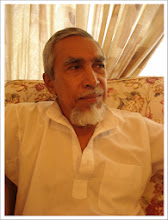1.
During my early teaching days I used to draw cartoons for a children newspaper Utusan
Pelajar published by Utusan Melayu.
I gave the title “Si Dogol” (Shaven Head) for my strip cartoons which centred on
a boy with shaven head. In those days pious parents would shave a son’s hair for
the sake of piety.
2.
I spent the remuneration money to buy story books for my class library. My
students enjoyed reading the books very much and I felt contented doing my bit
for the rural young generation. Early last year I happened to meet one of my
students at a wedding reception thrown by my friend. It had been a long time,
so naturally it was impossible for me to imagine who she was in my class nearly
50 years ago. But I nodded politely at what she was saying. She longed to see
me and felt very grateful to have met me that day. She remembered with fondness
the joy of reading the books I bought for the class library.
3.
Coming back to “Si Dogol,” I intended him to be a simpleton for sentimental
reasons. The character is my tribute to a student I knew when I was working as
a temporary teacher. He was a simpleton and considered “hopeless” (in his
study, that is) by most of his teachers at the time. The situation seemed to tie in with a quote I came across
from the famous physicist, Albert Einstein, “The only thing that interferes with my learning
is my education.”
4. Miraculously, years later I heard that the
“hopeless” student fared very well in vocational
skills training and in fact he was sent to England for further training
in carpentry. I believe he did it by
virtue of opportunities provided by the education system.
5. My cartoon contributions were short-lived,
however, for one reason or another. Only 25 of my strip cartoons were ever
published. In this post I’d like to share a few of the cartoons with the
readers.
6. Teaching in a rural school for nearly 10
years an episode as depicted in the cartoon below was a common experience for
me especially during the rainy season when students’ socks often got wet. Here
the culprit is “Dogol” himself who has carelessly taken off his shoes.
 |
| "Whose socks stink?" |
9. ‘Bulu ayam’ was an object that resembled a
shuttlecock. Three or four discs the size of a large coin were cut out of old
inner tube. The discs were layered and fixed together with a nail pierced
through the centre. Soft chicken feathers were tied around the nail with rubber
bands. The game was played by kicking and suspending the object in the air to
attain a target count agreed upon by the players.
10. You might have noticed the objects under
the boys’ chairs. Those are supposed to be ‘bulu ayam.’ The boys looked quite
nervous. You might have guessed what happened to the feather duster.
 |
| "What ever happened to this feather duster?" |
 |
| "Mama, throw the ball out, please." |

"Never--I want the part of Hang Jebat."
13. When the matter of Hang Jebat got
out of hand the bendahara revealed his secret to the sultan who readily
pardoned Hang Tuah and sent him to kill the traitor. By and by Hang Jebat died
at the hands of his comrade whose supposed death he avenged. A Malay scholar, Kassim Ahmad,
in his radical critique of Hikayat Hang Tuah had
elevated Hang Jebat as the true hero in the epic.












No comments:
Post a Comment